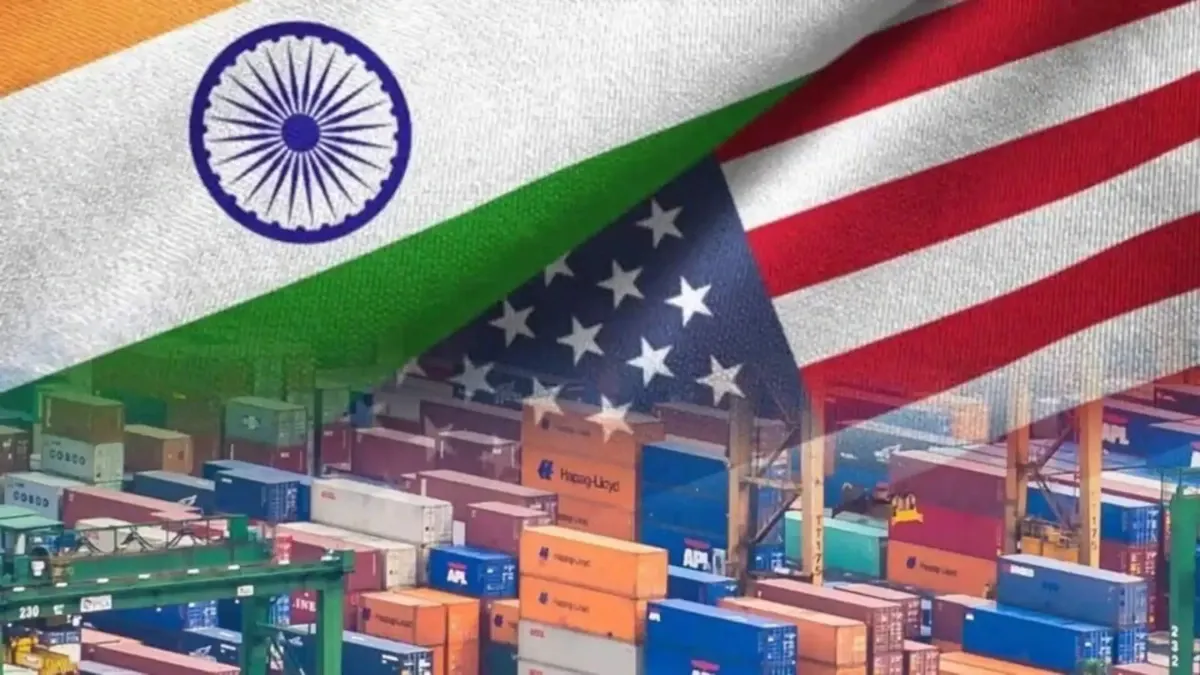A significant trade dispute is brewing between two of the world’s largest democracies, India and the United States, as New Delhi formally proposes retaliatory duties at the World Trade Organization (WTO). The move comes in response to Washington’s imposition of a 25 percent tariff on automobiles and certain auto parts, a measure India contends will adversely affect approximately $2.89 billion of its exports. This escalating trade friction highlights the complex and often contentious nature of bilateral economic relations, even amidst broader strategic partnerships.
According to an official notification, India has firmly stated its intent to “suspend concessions or other obligations… that are substantially equivalent to the adverse effects of the measure to India’s trade.” This means New Delhi plans to impose an “equivalent amount of duty collected from products originating in the United States,” which is estimated to be $725 million, mirroring the revenue the U.S. expects to collect from the tariffs on Indian goods. While India has not yet specified the exact tariff rate or the specific U.S. goods that will be targeted, the proposal signals a clear and decisive stance against what it perceives as protectionist trade practices.
This development unfolds against a backdrop of ongoing trade negotiations where India has indicated a willingness to lower some of its historically high tariff rates for the U.S., but has steadfastly refused to concede on Washington’s demands to open up its sensitive agriculture and dairy sectors. The situation is further complicated by a looming July 9 deadline set by U.S. President Donald Trump, who has threatened to impose a sweeping 26 percent tariff on all imported Indian goods if a trade deal is not reached. Indian Trade Minister Piyush Goyal has, however, dismissed the notion of negotiating under duress, asserting that “National interest will always be supreme” and that India will not conclude any trade deal merely to meet a deadline.
The stakes are high for both nations. Bilateral trade between India and the U.S. totaled approximately $129 billion in 2024, with U.S. exports to India reaching $41.8 billion and imports from India amounting to $87.4 billion, resulting in a trade deficit of $45.7 billion for the U.S. Despite these imbalances, India’s exports to the U.S. have shown robust growth, rising to $17.25 billion between April and May this year, up from $14.17 billion during the same period last year. This article will delve deeper into the origins of this dispute, the mechanisms of the WTO, the strategic considerations of both countries, and the potential broader implications for global trade.
The Escalating Trade Tensions: India’s Response
India’s proposal at the WTO is a direct and calculated response to the U.S. tariffs, signaling that New Delhi will not passively accept measures it deems detrimental to its economic interests. The principle of “suspending concessions or other obligations” is a standard tool within the WTO framework for countries seeking to offset the negative impact of another member’s trade-restricting measures.
The Mechanism of Retaliation
When a WTO member believes that another member has violated trade rules or nullified/impaired benefits under a trade agreement, they can initiate a dispute through the WTO’s Dispute Settlement Body (DSB). If the DSB rules in favor of the complaining party, and the offending party fails to implement the recommendations, the complaining party can request authorization to suspend concessions or obligations, effectively imposing retaliatory tariffs.
In this case, India is essentially stating that the U.S. 25% tariff on automobiles and auto parts constitutes a measure that negatively impacts its trade. The $2.89 billion figure represents India’s assessment of the “adverse effects” of these tariffs on its exports to the U.S. The proposed retaliation of imposing an “equivalent amount of duty collected” ($725 million) adheres to the WTO principle of proportionality, aiming to level the playing field by offsetting the estimated harm.
While India has reserved the right to choose which U.S. goods to target, the selection will be strategic. It will likely aim for products where U.S. exporters have a significant interest, thereby maximizing pressure on the U.S. to reconsider its tariffs, while minimizing negative impacts on India’s own consumers or industries. This could include agricultural products, certain manufactured goods, or even services, though the notification specifically mentions “products originating in the United States.”
The Auto Sector: A Point of Contention
The U.S. tariff on automobiles and auto parts is particularly sensitive. The global automotive industry operates on complex, interconnected supply chains, and tariffs on these products can have far-reaching consequences. India has a growing automotive sector, with significant export ambitions. Its exports to the U.S. in this category include not only finished vehicles but also a wide range of components and sub-assemblies. The 25% tariff could significantly increase the cost of Indian-made cars and parts in the U.S. market, making them less competitive and potentially leading to a decline in sales and market share for Indian manufacturers. This directly impacts revenue, employment, and investment in India’s auto industry.
The WTO’s Role in Global Trade Governance
The World Trade Organization serves as the primary international body regulating global trade. Its core functions include administering existing trade agreements, acting as a forum for trade negotiations, and, critically, providing a mechanism for resolving trade disputes.
Dispute Settlement Mechanism (DSM)
The WTO’s Dispute Settlement Mechanism (DSM) is considered one of the most robust and effective international dispute resolution systems. It aims to resolve trade conflicts peacefully and fairly, based on agreed-upon rules rather than economic might. The process typically involves several stages:
- Consultations: The first step, where the complaining and responding parties try to resolve the dispute amicably.
- Panel Establishment: If consultations fail, the complaining party can request the establishment of a panel of independent experts to hear the case.
- Panel Report: The panel issues a report, which includes findings and recommendations.
- Appellate Body Review: Either party can appeal the panel’s findings to the Appellate Body.
- Adoption of Report: The DSB adopts the panel and/or Appellate Body report, making the recommendations legally binding.
- Implementation: The losing party is expected to implement the recommendations. If they fail to do so within a reasonable period, the complaining party can request authorization to impose retaliatory measures (as India is proposing).
The effectiveness of the DSM has, however, faced challenges in recent years, particularly due to the impasse at the Appellate Body, which has been unable to hear new appeals since late 2019 due to blockages in the appointment of new members. This has left many disputes in a legal limbo, potentially encouraging countries to resort to unilateral measures or bilateral negotiations outside the formal WTO process. India’s decision to propose retaliatory duties at the WTO indicates a continued belief in the multilateral trading system, even with its current limitations.
Unpacking the U.S. Tariffs: Section 232 and Trade Policy
The U.S. 25% tariff on automobiles and auto parts is likely imposed under Section 232 of the Trade Expansion Act of 1962. This rarely-used provision allows the U.S. President to impose tariffs on imports if the Commerce Department determines that those imports threaten national security.
National Security Justification
The Trump administration previously used Section 232 to impose tariffs on steel and aluminum imports, arguing that reliance on foreign sources for these materials undermined U.S. national security. The application of Section 232 to the automotive sector would follow a similar logic, suggesting that a strong domestic auto industry is critical for national defense and economic security. Critics, however, often argue that such broad application of “national security” is a pretext for protectionism and undermines global trade rules.
The imposition of these tariffs reflects a broader shift in U.S. trade policy, particularly under the Trump administration, towards a more protectionist and unilateral approach. Key tenets of this approach include:
- Addressing Trade Deficits: A strong focus on reducing bilateral trade deficits, which are often viewed as indicators of unfair trade practices by partner countries.
- Protecting Domestic Industries: Prioritizing the safeguarding of American industries and jobs from foreign competition, sometimes through the use of tariffs.
- Bilateralism over Multilateralism: A preference for negotiating trade deals directly with individual countries rather than through multilateral bodies like the WTO.
- Aggressive Enforcement: A willingness to use trade remedies and tariffs to pressure trading partners into concessions.
This “America First” trade agenda has led to numerous trade disputes with key partners, including China, the European Union, and now, significantly, India.
India’s Strategic Position and Economic Sensitivities
India’s response to the U.S. tariffs is rooted in its own strategic economic priorities and sensitivities, particularly concerning its vast agricultural sector.
“National Interest Will Always Be Supreme”
Trade Minister Piyush Goyal’s assertion that “National interest will always be supreme” encapsulates India’s approach to trade negotiations. India, as a rapidly growing economy and a major global player, is increasingly assertive in defending its economic sovereignty. Its trade policy is often characterized by a blend of liberalization in some sectors and strategic protectionism in others, aimed at fostering domestic industry, ensuring food security, and protecting vulnerable livelihoods.
The concept of “national interest” for India often includes:
- Protecting Domestic Farmers: Agriculture is a cornerstone of the Indian economy, employing a significant portion of its population. The sector is highly sensitive to external competition, and opening it up to imports, particularly from highly subsidized agricultural economies like the U.S., could devastate millions of small and marginal farmers. This is why India has consistently resisted demands to liberalize its agriculture and dairy sectors.
- Promoting “Make in India”: The “Make in India” initiative is a flagship program aimed at boosting domestic manufacturing and attracting foreign investment to create jobs and enhance technological capabilities. Tariffs on imports, or the threat of them, are sometimes seen as tools to encourage local production and reduce reliance on foreign goods.
- Balancing Trade: While the U.S. focuses on its trade deficit with India, New Delhi is also keen on ensuring balanced trade relations that support its export growth and industrial development.
High Tariffs and Trade Negotiations
India has historically maintained relatively high tariff rates on a range of products compared to many developed economies. While it has shown a willingness to negotiate reductions, particularly in industrial goods, the resistance on agriculture and dairy remains a significant sticking point. The U.S. has long sought greater market access for its agricultural products in India, viewing it as a large, untapped market. However, for India, this is a matter of food security, rural livelihoods, and political stability.
The dismissal of President Trump’s July 9 deadline underscores India’s refusal to be pressured into a quick deal that it believes does not serve its long-term interests. This firm stance reflects India’s growing confidence on the global stage and its determination to negotiate on its own terms.
The Bilateral Trade Landscape: A Deeper Dive
The U.S. and India are significant trading partners, with a bilateral trade volume that reached approximately $129 billion in 2024. This figure, while substantial, also reveals a persistent trade imbalance that has been a source of friction.
Trade Imbalance and Key Products
In 2024, U.S. exports to India amounted to $41.8 billion, while imports from India were $87.4 billion, resulting in a trade deficit of $45.7 billion for the U.S. This deficit is a primary driver of the U.S. administration’s concerns and its push for greater market access in India.
Key U.S. exports to India typically include:
- Mineral fuels and oils: Crude oil, natural gas, and petroleum products.
- Pearls, precious stones, and metals: Diamonds, gold, and jewelry.
- Aircraft and spacecraft parts: Components for aviation and defense.
- Machinery and electrical equipment: Industrial machinery, computers, and electronics.
- Agricultural products: Cotton, almonds, and certain fruits.
On the other hand, major Indian imports to the U.S. include:
- Pharmaceuticals: Generic drugs and active pharmaceutical ingredients.
- Gems and jewelry: Cut and polished diamonds, gold jewelry.
- Textiles and apparel: Ready-made garments, fabrics.
- Information Technology (IT) services: Software services, business process outsourcing.
- Automobiles and auto parts: This is the sector directly targeted by the U.S. tariffs. India exports various components, sub-assemblies, and some finished vehicles to the U.S. market. The $2.89 billion affected exports specifically refer to these Indian auto and auto parts shipments.
The recent growth in India’s exports to the U.S., rising to $17.25 billion between April and May this year (up from $14.17 billion in the same period last year), indicates a healthy demand for Indian goods despite the ongoing trade tensions. This growth, however, could be jeopardized if the U.S. implements its threatened 26% tariff on all Indian goods.
Impact on Industries
The auto tariffs, and any potential retaliatory duties, will have tangible impacts on specific industries:
- Indian Auto Industry: Manufacturers exporting to the U.S. will face higher costs, potentially losing market share or being forced to absorb costs, impacting profitability. This could slow down investment and job creation in a key manufacturing sector.
- U.S. Auto Industry: While intended to protect U.S. manufacturers, tariffs on imported auto parts could increase production costs for U.S. carmakers that rely on these components, potentially leading to higher car prices for American consumers.
- U.S. Agricultural Sector: If India retaliates by targeting U.S. agricultural products, American farmers, who are already facing challenges from global trade disputes, could suffer significant losses in a potentially lucrative market.
Beyond Economics: Geopolitical Undercurrents
The U.S.-India relationship extends far beyond trade. Both nations share a growing strategic partnership, particularly in defense, technology, and regional security, often framed as a counterbalance to China’s rising influence. This broader geopolitical context adds a layer of complexity to the trade disputes.
Strategic Alignment vs. Trade Friction
Despite the trade friction, the U.S. and India are key partners in initiatives, which also includes Japan and Australia, aimed at promoting a free and open Indo-Pacific. They also engage in extensive defense cooperation, joint military exercises, and intelligence sharing.
This strategic alignment means that neither side wants the trade disputes to completely derail the broader relationship. There’s an underlying imperative to manage these economic disagreements without undermining critical security and diplomatic ties. However, persistent trade irritants can strain trust and make cooperation in other areas more challenging. The U.S. often views India as a crucial economic partner in its Indo-Pacific strategy, aiming to reduce reliance on China for supply chains. Trade disputes, however, can complicate this objective.
Potential Economic Fallout and Global Implications
An escalation of the U.S.-India trade dispute carries significant risks, not just for the two countries involved but for the broader global trading system.
Risk of a Wider Trade War
The threatened 26% tariff on all imported Indian goods by President Trump, if implemented, would represent a massive escalation. Such a move would likely trigger a full-blown trade war, with India almost certainly retaliating against a wider range of U.S. products. This would:
- Disrupt Global Supply Chains: Companies that rely on components or finished goods from either country would face increased costs, delays, and the need to reconfigure their supply networks.
- Increase Consumer Prices: Tariffs are essentially taxes on imports, which are often passed on to consumers in the form of higher prices. This could contribute to inflationary pressures in both the U.S. and India.
- Reduce Global Trade Volumes: Trade wars generally lead to a contraction in international trade, harming economic growth worldwide.
- Undermine the WTO: Persistent unilateral actions and tit-for-tat tariffs further weaken the multilateral trading system and the rules-based order that has underpinned global prosperity for decades.
Impact on Global Auto Industry
The auto industry is particularly vulnerable to trade wars due to its globalized nature. Tariffs on vehicles and parts can fragment production, increase costs, and reduce demand, impacting major automotive hubs worldwide. Both the U.S. and India are significant players in the global auto supply chain, and an extended dispute could have ripple effects across the industry.
The Road Ahead: Negotiations and Deadlines
The immediate future of the U.S.-India trade dispute hinges on the outcome of ongoing negotiations and the willingness of both sides to find common ground.
Diplomatic Maneuvers
Despite the public statements and WTO filings, diplomatic channels remain open. Both countries have an interest in de-escalating tensions, given their broader strategic partnership. Negotiations will likely focus on:
- Market Access: The U.S. will continue to press for greater access to India’s markets, particularly for agricultural and dairy products.
- Tariff Reductions: India may offer concessions on some industrial tariffs in exchange for the removal of U.S. auto tariffs and the withdrawal of the broader tariff threat.
- Trade Deficit Concerns: The U.S. will seek assurances on how the trade imbalance will be addressed.
However, as Minister Goyal indicated, India is unlikely to compromise on its core “national interest” issues, especially those affecting its vast agricultural population.
The July 9 Deadline and Political Context
The July 9 deadline set by President Trump adds immediate pressure. His administration has a track record of using deadlines and tariff threats as leverage in trade negotiations. However, India’s firm stance suggests it will not yield to such tactics if it perceives the proposed deal as unfavorable.
The upcoming U.S. presidential election also casts a long shadow over these trade dynamics. A new administration, or a second term for President Trump, could bring different trade priorities and approaches. This uncertainty might influence the pace and nature of current negotiations.
Conclusion: Navigating a Complex Partnership
The current trade dispute between India and the United States represents a critical test for their evolving relationship. While both nations share deep strategic interests and growing bilateral trade, fundamental disagreements over market access, tariffs, and trade balances continue to create friction.
India’s proposal for retaliatory duties at the WTO underscores its commitment to defending its economic sovereignty and its willingness to use multilateral mechanisms to address perceived unfair trade practices. The U.S. tariffs, rooted in a protectionist stance and national security justifications, reflect a broader shift in its trade policy.
The path forward will require careful diplomatic navigation, a willingness from both sides to find mutually beneficial solutions, and a recognition that an escalating trade war would harm not only their respective economies but also the stability of the global trading system. The resolution of this dispute will be a key indicator of how two major powers can manage economic competition while fostering a broader strategic partnership in an increasingly complex world.
Ready to take your career to the next level? Join our dynamic courses: ACCA, HESI A2, ATI TEAS 7 , HESI EXIT , NCLEX – RN and NCLEX – PN, Financial Literacy!🌟 Dive into a world of opportunities and empower yourself for success. Explore more at Serrari Ed and start your exciting journey today! ✨
photo source: Google
By: Montel Kamau
Serrari Financial Analyst
7th July, 2025
Article, Financial and News Disclaimer
The Value of a Financial Advisor
While this article offers valuable insights, it is essential to recognize that personal finance can be highly complex and unique to each individual. A financial advisor provides professional expertise and personalized guidance to help you make well-informed decisions tailored to your specific circumstances and goals.
Beyond offering knowledge, a financial advisor serves as a trusted partner to help you stay disciplined, avoid common pitfalls, and remain focused on your long-term objectives. Their perspective and experience can complement your own efforts, enhancing your financial well-being and ensuring a more confident approach to managing your finances.
Disclaimer: This article is for informational purposes only and does not constitute financial advice. Readers are encouraged to consult a licensed financial advisor to obtain guidance specific to their financial situation.
Article and News Disclaimer
The information provided on www.serrarigroup.com is for general informational purposes only. While we strive to keep the information up to date and accurate, we make no representations or warranties of any kind, express or implied, about the completeness, accuracy, reliability, suitability, or availability with respect to the website or the information, products, services, or related graphics contained on the website for any purpose. Any reliance you place on such information is therefore strictly at your own risk.
www.serrarigroup.com is not responsible for any errors or omissions, or for the results obtained from the use of this information. All information on the website is provided on an as-is basis, with no guarantee of completeness, accuracy, timeliness, or of the results obtained from the use of this information, and without warranty of any kind, express or implied, including but not limited to warranties of performance, merchantability, and fitness for a particular purpose.
In no event will www.serrarigroup.com be liable to you or anyone else for any decision made or action taken in reliance on the information provided on the website or for any consequential, special, or similar damages, even if advised of the possibility of such damages.
The articles, news, and information presented on www.serrarigroup.com reflect the opinions of the respective authors and contributors and do not necessarily represent the views of the website or its management. Any views or opinions expressed are solely those of the individual authors and do not represent the website's views or opinions as a whole.
The content on www.serrarigroup.com may include links to external websites, which are provided for convenience and informational purposes only. We have no control over the nature, content, and availability of those sites. The inclusion of any links does not necessarily imply a recommendation or endorsement of the views expressed within them.
Every effort is made to keep the website up and running smoothly. However, www.serrarigroup.com takes no responsibility for, and will not be liable for, the website being temporarily unavailable due to technical issues beyond our control.
Please note that laws, regulations, and information can change rapidly, and we advise you to conduct further research and seek professional advice when necessary.
By using www.serrarigroup.com, you agree to this disclaimer and its terms. If you do not agree with this disclaimer, please do not use the website.
www.serrarigroup.com, reserves the right to update, modify, or remove any part of this disclaimer without prior notice. It is your responsibility to review this disclaimer periodically for changes.
Serrari Group 2025












